Abstract
The risk of explosive spalling in high-strength cement-based materials during fire exposure poses a significant threat to structural integrity. To help mitigate this issue, this study explores the use of expanded polystyrene (EPS) beads as both a lightweight filler and a potential spalling-reduction agent in lightweight geopolymer and conventional cementitious mortars. Two EPS-containing mortars were developed: a lightweight alkali-activated slag (LWAS) mortar and a conventional lightweight Portland cement (LWPC) mortar, both incorporating EPS beads as a 50% volumetric replacement for sand. Specimens from both mortars were subjected to elevated temperatures of 200 °C, 400 °C, and 600 °C at a heating rate of 10 °C/min to simulate a rapid-fire scenario. Following thermal exposure, two cooling regimes were employed: gradual cooling within the furnace and rapid cooling by water immersion. Mechanical performance was evaluated through compressive, splitting tensile, and impact tests at room and elevated temperatures. Microstructural analysis was also conducted to examine internal changes and heat-induced damage. The results indicated that LWAS showed remarkable resistance to spalling, remaining intact up to 600 °C due to its nanoporous geopolymer structure, which allowed controlled steam release, while LWPC failed explosively at 550 °C despite EPS pores. At 400 °C, EPS beads enhanced thermal insulation in LWAS, lowering internal temperature by over 100 °C, but increased porosity led to faster strength loss. Both mortars gained strength at 200 °C from continued curing, yet LWAS retained strength better at high temperatures than LWPC. Microscopy revealed that EPS created beneficial fine cracks in the slag matrix but harmful voids in cement. Overall, LWAS composites offer excellent spalling resistance for fire-prone environments, though reinforcement is recommended to mitigate strength loss.
1. Introduction
The preservation of concrete’s structural integrity during fire events is critically important for mitigating severe structural, economic, and operational losses. This necessity drives significant research into the development of advanced fire-resistant construction materials. Although concrete formulated with Ordinary Portland Cement (OPC) continues to dominate the construction industry [1,2], ordinary high-strength composite (OHSC) exhibits greater susceptibility to deterioration in both strength and durability than its normal-strength counterpart. Moreover, OHSC demonstrates a markedly higher propensity for explosive spalling under thermal or mechanical stress conditions [3,4]. This phenomenon, involving the violent detachment of surface material, has been experimentally documented at temperatures as low as 200–300 °C [3,5,6]. The primary mechanisms driving this failure are the material’s intrinsically low permeability and highly dense microstructural composition [3,7]. Accordingly, lightweight concrete systems formulated with high-strength matrices (OHSC-derived) may also exhibit susceptibility to explosive cracking under rapid heating, as the dense and brittle binder phase limits vapor dissipation despite the inherently superior thermal insulation of lightweight composites [6]. Compounding these performance issues, the manufacturing process for OPC carries a substantial environmental burden; it is estimated that each ton of OPC produced generates approximately one ton of CO2, contributing an estimated 5–7% of worldwide anthropogenic CO2 emissions [8,9,10,11]. Consequently, the dual challenges of thermal instability and considerable carbon footprint have catalyzed the pursuit of novel, sustainable lightweight high-strength composites engineered for enhanced fire performance and resistance to explosive spalling.
Alkali-activated composites (AACs) have garnered significant research attention as promising zero-cement substitutes. These materials utilize industrial aluminosilicate-rich by-products—including blast furnace slag, fly ash, and metakaolin—that undergo alkaline activation to form cohesive binding phases [12,13,14,15,16,17]. AACs are characterized by a suite of advantageous properties, such as high mechanical strength, extended service life, thermal resistance, and a marked capacity to suppress alkali-silica reactions (ASR), in addition to inherent resistance to chemical and thermal deterioration [18,19,20]. A key feature contributing to their performance under fire is the nanoporous structure of AACs, which is instrumental in preventing explosive spalling at high temperatures. This combination of attributes positions AACs, unlike OHSC, as a viable high-strength matrix for fabricating lightweight concrete (LWC) that integrates high strength, spalling resistance, and environmental sustainability [21,22,23,24,25,26]. The utilization of LWC itself confers numerous benefits, such as a superior strength-to-weight ratio, diminished seismic forces, upgraded fire ratings, and better thermal insulation qualities [21,22,23,24,25,26]. Furthermore, enhanced insulation can yield considerable energy conservation by reducing the operational load on heating, ventilation, and air conditioning (HVAC) systems, which represent a major portion, potentially up to 60%, of a building’s total energy expenditure [27,28].
Notwithstanding the enhanced fire resilience of lightweight concrete (LWC), its vulnerability to explosive spalling under severe thermal loading persists, especially in high-strength formulations [6]. The empirical data on this phenomenon are notably scarce. A study by Aslani and Ma [6], for example, documented significant explosive spalling in high-strength lightweight self-compacting concrete (HSLWSC) subjected to 300 °C for one hour at a heating rate of 5 °C/min. The integration of polymeric fibers—such as polypropylene [29], polyvinyl alcohol [30], acrylic [31], nylon [32], and recycled polyethylene terephthalate (PET) [33]—has been proposed as a mitigation strategy to promote pore pressure release. Despite these investigations, a review of the extant literature reveals a conspicuous absence of research examining the efficacy of EPS in preventing explosive spalling within lightweight, high-strength concrete systems. EPS is a thermoplastic foam material distinguished by its closed-cell configuration, which confers a very low density, superior thermal insulation capacity, hydrophobicity, and stability in acidic and alkaline media [34,35]. The utilization of EPS beads as a concrete constituent offers a dual benefit: it serves as a partial replacement for natural aggregates and provides a waste management pathway for discarded EPS, thereby addressing environmental concerns associated with its disposal [36].
A substantial body of research has systematically characterized the post-fire mechanical properties and spalling behavior of OHSC [3,5,6,37,38,39,40,41,42,43,44,45,46,47,48,49,50,51,52,53,54] and high-strength alkali-activated composites (HSAAC) [55,56,57,58,59,60,61,62,63,64,65,66] following exposure to elevated temperatures, predominantly under air-cooling regimes. Despite this extensive focus, a clear research gap exists concerning the thermal performance and residual mechanical integrity of lightweight high-strength systems incorporating expanded polystyrene (EPS) aggregates, whether based on Ordinary Portland Cement (LWPC) or alkali-activated technology (LWAS). Investigations into conventional materials have established specific thermal response patterns. For instance, a study by Matesov et al. [5] on ordinary high-strength mortar (OHSM) employing a heating rate of 10 °C/min for one hour reported an initial increase in compressive strength and elastic modulus between 200 and 300 °C, succeeded by a progressive deterioration up to 600 °C. Although alkali-activated composites (AAC) are frequently reported to exhibit superior thermal resilience and durability compared to their OPC-based counterparts [55,56,59,60,61], they are not entirely immune to thermal degradation. In particular, substantial reductions in compressive strength have been observed in AAC specimens cooled in air following exposure to 400, 600, and 800 °C [57,58,62,63,64,65,66].
The influence of water cooling on the mechanical properties and spalling resistance OHSC has also been the subject of considerable research [66,67,68,69,70,71,72,73,74,75,76,77]. Findings indicate that exposure to temperatures beyond 200 °C can result in a higher residual compressive strength under water cooling versus air cooling. This enhancement is frequently ascribed to a compaction of the microstructure and a reduction in porosity, mechanisms driven by the rehydration of unhydrated cement particles and the sealing of microcracks, thereby improving post-fire performance [67,70,71,72,73,74,75,76]. Conversely, an alternative body of evidence reports a detrimental effect, where water quenching leads to a reduction in strength [68,69,77]. This decline is often explained by severe thermal shock and the volumetric expansion of rehydrated compounds, phenomena that induce new microcracking and compromise the material’s integrity [68,69,77]. Notwithstanding this comprehensive analysis of conventional systems, the response to water cooling remains entirely uninvestigated for both lightweight high-strength Portland cement (LWPC) and lightweight alkali-activated slag (LWAS) composites incorporating EPS.
2. Research Significance
While the behavior of conventional high-strength and alkali-activated concretes under long-term fire exposure is well-documented, their performance under short-term, high-intensity thermal transients—such as those occurring during flash fires or rapidly extinguished incidents—remains largely unexplored. This study addresses this critical gap by investigating the response of both composite materials under these extreme but brief conditions, incorporating EPS beads. This work makes a unique contribution to the field by: (i) pioneering the use of EPS as a dual-purpose aggregate for both lightweighting and spalling resistance, offering a sustainable use for EPS waste; (ii) presenting a comparative analysis of LWPC and LWAS under identical rapid heating and cooling regimes; (iii) evaluating the effect of post-fire cooling methods, simulating real-world firefighting scenarios; and (iv) comparing mechanical degradation with microstructural changes through SEM/EDS analysis, offering mechanistic insights into thermal failure pathways. The outcome of this study lies in the identification of novel materials and strategies for improving the fire resistance of concrete in scenarios involving rapid thermal transients, with significant implications for both construction safety and sustainability.
3. Experimental Program
3.1. Materials and Mixtures
This investigation involved the development and analysis of four distinct mortar mixtures, categorized as follows:
- High-Strength Alkali-Activated Mixture (HSAAM): A normal-weight reference mixture formulated using ground granulated blast-furnace slag as the primary aluminosilicate precursor. The slag had a specific gravity of 2.61 and a Blaine fineness of approximately 420 m2/kg. Its chemical composition is detailed in Table 1. The alkaline activator consisted of sodium silicate (Na2SiO3) solution and sodium hydroxide (NaOH) pellets (99% purity), with their respective chemical profiles provided in Table 2. Natural sand served as the fine aggregate.
 Table 1. Chemical Characterization of OPC, GGBFS, and SF.
Table 1. Chemical Characterization of OPC, GGBFS, and SF. Table 2. Chemical Analysis of Sodium Silicate and Sodium Hydroxide.
Table 2. Chemical Analysis of Sodium Silicate and Sodium Hydroxide. - Lightweight Alkali-Activated Mixture (LWAS): This mixture was derived from the HSAAM formulation but incorporated EPS beads as a partial volumetric replacement (50%) for the natural sand. The objective was to evaluate the efficacy of EPS in simultaneously reducing density and mitigating explosive spalling within an alkali-activated matrix.
- High-Strength Conventional Mixture (HSCM): A normal-weight Portland cement-based control mixture employing a binary binder system of 91% ordinary Portland cement (CEM I 52.5N) and 9% silica fume. The cement had a specific gravity of 3.14 and a Blaine fineness of about 340 m2/kg. The Chemical properties of these constituents are summarized in Table 1. Natural sand was utilized as fine aggregate.
- Lightweight Conventional Mixture (LWPC): This mixture was based on the HSCM design but included EPS beads as a 50% volumetric substitute for sand. Its purpose was to assess the dual role of EPS as a lightweight filler and a potential agent for spalling reduction in conventional concrete systems.
The precise proportions for all mixtures are cataloged in Table 3 and Table 4. The HSAAM and HSCM were designed as reference baselines for the lightweight LWAS and LWPC composites, respectively. Crucially, both reference mixtures were engineered to attain equivalent 28-day compressive strengths under ambient curing conditions (77.8 MPa for HSAAM and 76 MPa for HSCM). Both reference mixes were designed through preliminary trials to achieve similar 28-day strength, ensuring a fair comparison between the two systems. This deliberate parity in mechanical performance was established to isolate and evaluate the influence of mixture design and lightweight aggregate incorporation, independent of strength variability.

Table 3.
Quantities of Constituent Materials (in kg) for Producing 1 m3 of HSAAM and LWAS.

Table 4.
Quantities of Constituent Materials (in kg) for the Production of 1 m3 of HSCM and LWPC.
To ensure adequate workability across all formulations, a superplasticizer was introduced at a constant dosage equivalent to 3% of the cementitious content by weight. The fine aggregate employed in all mixtures consisted of natural sand, which was sieved to a particle size distribution of 0.15–5 mm. This aggregate possessed a specific gravity of 2.65 and a fineness modulus of 2.25; its gradation curve is illustrated in Figure 1. For the lightweight mixtures (LWAS and LWPC), EPS beads—sourced locally, with a diameter range of 3–5 mm and a specific density of 13.1 kg/m3—were used as a partial replacement for natural sand to function as a lightweight aggregate.
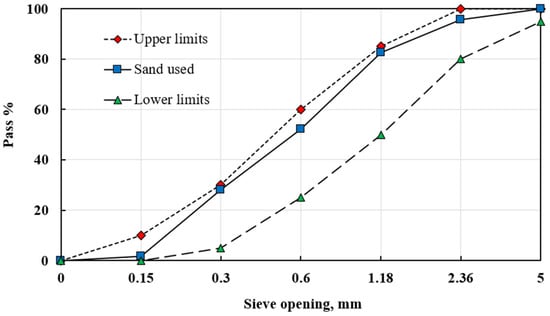
Figure 1.
Gradation curve for the natural sand compared to the upper and lower bounds of the Egyptian standard specification [78].
3.2. Mixing Methodology
The mixing procedures were conducted as follows: For the HSAAM, the alkaline activator was first prepared by dissolving sodium hydroxide (NaOH) granules and sodium silicate (Na2SiO3) solution in the requisite amount of water to achieve a fixed water-to-binder ratio of 0.35. This solution was stirred until the NaOH was completely dissolved. The resultant activator was then introduced to the slag in a pan mixer and blended for 3 min. Subsequently, the natural sand was added and mixed for a further 5 min. The LWAS mixture followed an identical sequence, with the modification that EPS beads were introduced 2 min after combining the alkaline solution with the slag. The sand was added thereafter, and mixing continued for the prescribed duration. As noted in reference [79], the highly viscous and cohesive nature of the fresh alkali-activated matrix prevents the segregation of EPS beads and ensures a homogeneous distribution. The HSCM was prepared by dry mixing the ordinary Portland cement, silica fume, and sand for 2 min. The water, containing the superplasticizer, was then added gradually, and wet mixing proceeded for approximately 5 min. For the LWPC mixture, the procedure mirrored that of HSCM, with the exception that EPS beads were added 3 min after the water introduction, followed by a final 2 min of mixing. Upon completion of mixing for all formulations, the fresh concrete was cast into cubic molds. The lightweight concrete formulations (LWAS and LWPC) were designed with a sufficiently high paste content to ensure a viscous matrix, thereby mitigating the buoyancy and segregation of the EPS beads, a methodology consistent with established practices [6,80]. The efficacy of this approach is confirmed in Figure 2, which illustrates a homogeneous dispersion of EPS beads within the cross-section of the hardened specimens. Additionally, Figure 2c presents EPS beads used as lightweight inclusions. Following a 24-h curing period in the molds, all specimens were demolded and subsequently subjected to water curing at a controlled temperature of 20 ± 3 °C for 27 days.

Figure 2.
Visual representation of EPS incorporation and distribution: (a) cross-section of LWAS; (b) cross-section of LWPC; and (c) EPS beads used as lightweight aggregate before mixing.
3.3. Heating and Cooling Methods
Upon completion of a 28-day water curing regimen, the specimens were extracted and permitted to air-dry under ambient laboratory conditions for a 24-h period. To further minimize internal moisture and mitigate potential explosive spalling, the samples underwent additional drying in a controlled oven environment at 105 °C for two hours preceding thermal exposure. The heating protocol was executed using a compact electric furnace (Figure 3), featuring a chamber capacity for two 100 mm cubic specimens and heating elements arranged along two vertical surfaces. A constant heating rate of 10 °C/min was maintained throughout the thermal treatment, acknowledging that such rapid heating may induce significant thermal stresses in specimens of this scale, as documented in previous studies [67,68]. After achieving the target temperature, isothermal conditions were maintained for prescribed durations of 10, 20, or 30 min. Subsequently, two cooling methodologies were implemented: furnace cooling, wherein specimens underwent gradual temperature reduction within the semi-open furnace until reaching ambient conditions; and water quenching, involving immediate transfer of heated specimens to immersion in room-temperature water for exactly 5 min, followed by air-cooling to equilibrium temperature. To monitor internal temperature evolution and evaluate the thermal insulation characteristics of the LWAS and LWPC composites, a thermocouple was centrally embedded within a designated sacrificial cube for each configuration, as illustrated in Figure 4. This thermocouple was interfaced with a data acquisition system configured to record core temperature measurements at 5-s intervals. Owing to the constrained dimensions of the heating chamber (Figure 3), the furnace temperature demonstrated close correspondence with the surface temperature of the specimens. The installation procedure for the type K thermocouple involved drilling an 8 mm diameter hole to a depth of 50 mm at the center of each cube (see Figure 4), following an initial 7-day water curing period. The thermocouple was subsequently inserted, and the cavity sealed with a mortar composition identical to that of the respective specimen. The instrumented cubes were then returned to water curing for an additional 21 days prior to thermal testing, ensuring complete maturity before exposure to elevated temperatures. The experimental nomenclature system identifies specimens according to four parameters: matrix type (S for alkali-activated or C for conventional Portland cement), EPS incorporation level (0% or 50% by volume), thermal soaking duration (10, 20, or 30 min), and cooling method (F for furnace cooling or W for water quenching). For instance, the designation C/50/30/W corresponds to a lightweight Portland cement composite containing 50% EPS, exposed to 30 min of isothermal conditioning, and subsequently cooled via water immersion.
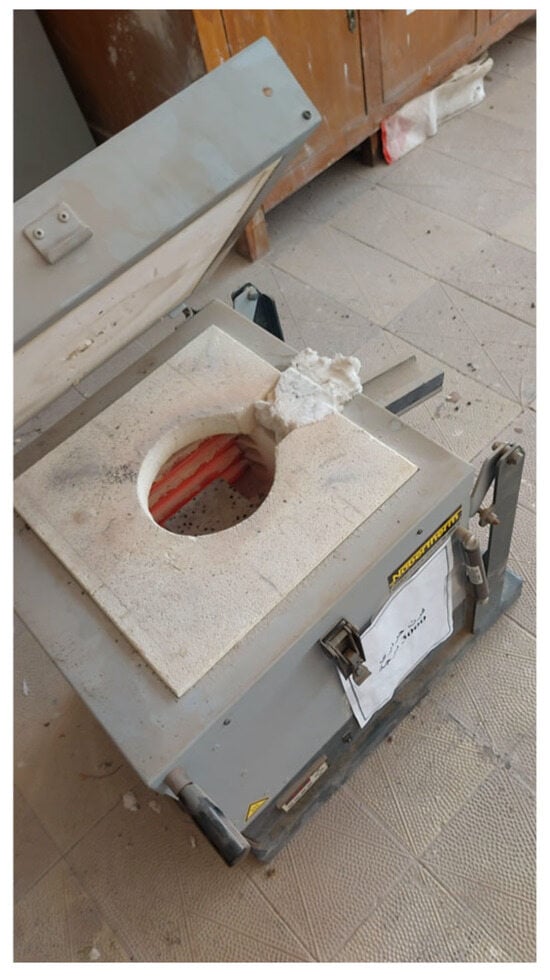
Figure 3.
Furnace Heating Procedure.
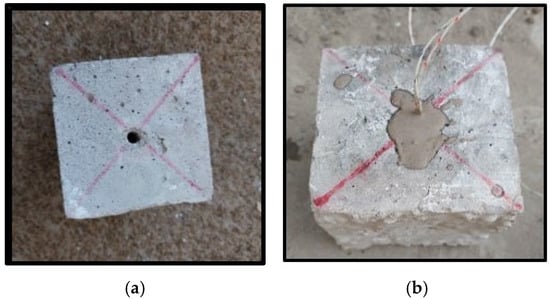
Figure 4.
Installing type K thermocouples in specimens: (a) drilling the specimen, (b) installing the thermocouples.
3.4. Evaluation of Mechanical Properties and Microscopic Analysis
The mechanical properties of the specimens, encompassing compressive strength, splitting tensile strength, and impact resistance, were evaluated at ambient temperature following 7 and 28 days of curing. Subsequent to exposure to elevated temperatures under varying soaking durations, the specimens underwent either furnace cooling or water quenching and were permitted to stabilize at room temperature for 24 h prior to residual strength testing. Residual compressive strength was determined through compression tests performed on 100 mm cubes, in compliance with BS EN 12390-3 [81]. Residual splitting tensile strength assessment followed the guidelines of BS EN 12390-6 [82]. Impact resistance was quantified employing a drop-weight test methodology in accordance with ACI 544.2R-89 [83]. A 4.5 kg steel mass was released repeatedly from a height of 450 mm, permitting free fall under gravitational acceleration (9.81 m/s2). The number of impacts necessary to induce initial cracking (Ni) and to achieve ultimate failure (Nf) was documented for each specimen. Initial cracking was defined as the first appearance of a hairline fracture on the specimen’s top surface, while ultimate failure was identified through crack propagation and displacement of material fragments beyond the specimen’s perimeter. The values Ni and Nf were correspondingly designated as indicators of initial crack resistance and final failure resistance. Microstructural examination was performed using a scanning electron microscope (JEOL JSM-6510LV, JEOL GULF FZCO, Dubai, UAE) capable of achieving high magnifications up to 300,000×. Several magnification levels were utilized to capture representative microstructural features and enable detailed morphological characterization, including the identification of cracks and pores. The imaging was conducted under the Secondary Electron (SE) mode to obtain topographical contrast that clearly revealed surface texture and microstructural morphology. Samples for microscopic analysis were collected from regions approximately 10 mm beneath the surface of fractured cube specimens after completion of the 28-day compressive strength test. The extracted fragments were desiccated at 70 °C until mass stabilization was achieved, then mounted on carbon adhesive substrates. To enhance image clarity and minimize charging effects, each specimen was coated with a thin layer of gold via sputter coating evaporation. Complementary chemical composition analysis was performed through energy-dispersive X-ray spectroscopy (EDS) using an Oxford X-Max 20 detector system. The EDS analyses were conducted in both spot and area mapping modes on the same regions of interest identified in the SE micrographs to correlate morphological observations with local elemental composition.
4. Results and Discussion
4.1. The Influence of Heating Duration and Cooling Methodology on the Compressive Strength of the S/50 Mixture
Figure 5 illustrates the variation in residual compressive strength for S/50 specimens following application of water and furnace cooling protocols. Initial compressive strength values for the S/50 mixture, prior to thermal exposure, were 33.3 MPa after 7 days and 37.4 MPa after 28 days of curing. These values represent a substantial reduction of 52.2% and 50.5% relative to the S/0 mixture at 7 and 28 days, respectively, where the reference mixture achieved strengths of 67.9 MPa and 75.5 MPa. This significant decrease in mechanical performance is primarily attributable to the incorporation of EPS aggregates, whose inherent low strength and high compressibility compromise the structural integrity of the composite matrix [27,84].
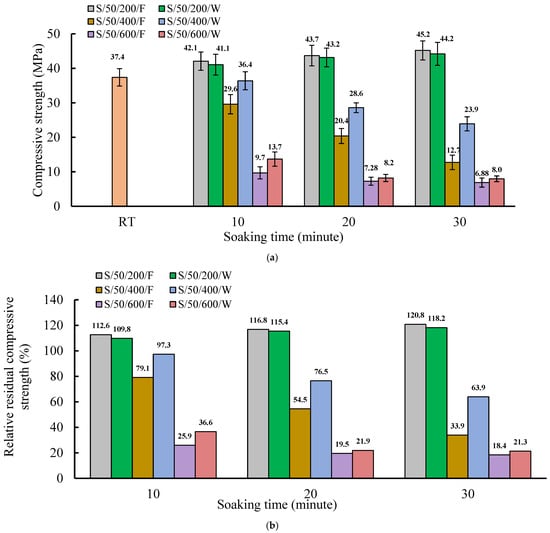
Figure 5.
(a) The residual compressive strength for S/50, (b) relative residual compressive strength for S/50.
Following exposure to 200 °C, a notable enhancement in compressive strength was observed across all tested conditions. Furnace-cooled specimens demonstrated strength increases of 12.6%, 16.8%, and 20.8% after 10, 20, and 30 min of thermal soaking, respectively, relative to their ambient temperature strength. Water-cooled specimens similarly exhibited strength gains, though to a lesser extent, with improvements of 9.9%, 15.5%, and 18.3% for corresponding soaking durations. These results indicate a consistent trend of strengthening with prolonged thermal exposure, irrespective of cooling method. Nevertheless, the superior performance retention in furnace-cooled specimens highlights the detrimental effect of thermal shock associated with rapid water quenching. The observed strength enhancement at moderate temperatures aligns with findings reported in the literature [61,73,85,86], suggesting possible microstructural densification mechanisms within the alkali-activated matrix under controlled thermal conditions. The observed strength enhancement at 200 °C is primarily ascribed to microstructural densification and increased rigidity of the N-A-S-H (sodium aluminosilicate hydrate) and C-A-S-H (calcium aluminosilicate hydrate) gels induced by thermal treatment [61,86,87]. Supplementary mechanisms may involve continued hydration of unreacted binder particles under the influence of internal steam, replicating autoclave-like conditions that promote reaction completeness [73,88]. The superior performance of furnace-cooled specimens relative to water-quenched counterparts suggests that rapid cooling may partially inhibit these beneficial processes, potentially limiting the rehydration of anhydrous phases. The maximum compressive strength recorded at this temperature was 45.2 MPa for furnace-cooled specimens subjected to 30 min of thermal exposure.
Conversely, exposure to 400 °C resulted in progressive strength deterioration with increasing soaking duration. Furnace-cooled specimens exhibited compressive strength reductions of 20.9%, 45.5%, and 66.1% after 10, 20, and 30 min of exposure, respectively. Water-cooled specimens demonstrated comparatively lower degradation, with strength reductions of 2.7%, 23.5%, and 36.1% for equivalent durations. This divergent behavior suggests that water cooling provides a protective effect at elevated temperatures, potentially through rehydration of thermally degraded phases that partially seal microcracks and enhance microstructural cohesion [67,70,71,72,73,74,75,76]. Furthermore, the rapid thermal reduction achieved through water quenching minimizes prolonged exposure to deleterious temperatures, thereby reducing microstructural coarsening and associated strength loss [45,89,90]. These findings correlate with earlier reports by Koskal et al. [76] indicating superior residual performance in water-cooled specimens compared to air-cooled analogues under similar thermal conditions.
The deterioration in compressive strength observed at 400 °C for both cooling regimes is principally associated with dehydration-induced shrinkage cracking and decomposition of the calcium aluminosilicate hydrate (C-A-S-H) phase. These processes are accompanied by thermal microcracking, increased porosity, and microstructural coarsening [61,69,91,92,93]. Notably, EPS aggregates within the specimens exhibited minimal decomposition, as core temperatures reached only 102 °C after 30 min of exposure at 400 °C—significantly below the EPS disintegration threshold of approximately 205 °C specified by the manufacturer. Quantitative analysis revealed higher residual EPS content in water-cooled specimens compared to furnace-cooled counterparts, attributable to the rapid thermal reduction during quenching, which limited thermal exposure. At 600 °C, furnace-cooled specimens demonstrated compressive strength reductions of 74.1%, 80.5%, and 81.6% after 10, 20, and 30 min of exposure, respectively. Water-cooled specimens showed marginally lower degradation, with reductions of 63.4%, 78.1%, and 78.7% for equivalent durations. The progressive strength loss with extended thermal exposure aligns with microstructural alterations, including advanced gel decomposition, formation of crystalline phases (eckermannite, anorthite, nepheline), and development of a highly porous matrix [61,69,91,92,93]. An additional degradation mechanism involves the α-β quartz phase transformation in sand aggregates at approximately 573 °C, inducing 0.85% volumetric expansion and consequent microcracking [68,94].
The diminished differential in mechanical performance between cooling methods at 600 °C suggests that microstructural damage occurs predominantly during high-temperature exposure rather than during the cooling phase. This observation implies that the cooling mechanism exerts limited influence on final strength properties when specimens are subjected to temperatures exceeding critical decomposition thresholds [95].
4.2. The Influence of Heating Duration and Cooling Methodology on the Compressive Strength of the C/50 Mixture
This study examined the influence of elevated temperatures (200 °C, 400 °C, and 600 °C), exposure durations (10, 20, and 30 min), and cooling techniques (furnace cooling and water quenching) on the residual compressive strength of the C/50 mixture, see Figure 6. Initial compressive strengths for the C/50 composite were recorded at 26.5 MPa after 7 days and 31.5 MPa following 28 days of curing. These values represent reductions of 56.5% and 58.5%, respectively, compared to the reference C/0 mixture, which achieved 61 MPa at 7 days and 76 MPa at 28 days. This strength reduction is consistent with known effects of EPS incorporation, attributable to the material’s low inherent strength and high compressibility [27,84]. Following exposure to 200 °C, furnace-cooled specimens demonstrated strength enhancements of 4.4%, 6.3%, and 11.1% after 10, 20, and 30 min of thermal exposure, respectively. Water-quenched specimens exhibited more moderate improvements of 1.6%, 3.8%, and 7.9% under identical conditions. These results indicate a positive correlation between thermal exposure duration and compressive strength retention, with gradually cooled specimens displaying superior performance. The observed strength enhancement is principally ascribed to continued hydration of previously unhydrated cement particles and subsequent formation of additional C-S-H-type gels involving silica fume [73,96,97]. The differential performance between cooling methods suggests that the gradual thermal equilibration afforded by furnace cooling promotes more complete rehydration processes compared to the thermal shock induced by water quenching. Exposure to 400 °C resulted in progressive strength reduction for both cooling regimes, with furnace-cooled C/50 specimens exhibiting decreases of 5.4%, 10.5%, and 15.5% after 10, 20, and 30 min of thermal exposure, respectively. Water-cooled specimens demonstrated comparatively lower degradation, with strength reductions of 1.6%, 6.0%, and 11.8% for equivalent durations. The observed strength deterioration intensified with prolonged thermal exposure, with furnace-cooled specimens displaying more pronounced weakening. This behavior is partially attributable to the thermal degradation of EPS inclusions, which increases porosity and promotes microcracking, consistent with observations by Lo Monte et al. [98]. The superior residual performance of water-cooled specimens aligns with findings reported by Koksal et al. [76] for high-strength mortars, where quenching yielded enhanced strength retention following exposure to 300 °C and 600 °C. This phenomenon is largely explained by the rehydration of lime (CaO), derived from portlandite decomposition, during the quenching process. The subsequent formation of Ca(OH)2 fills microcracks and enhances microstructural density. Furthermore, rapid cooling minimizes prolonged exposure to deleterious temperatures, thereby reducing microstructural coarsening and preserving mechanical integrity [45,89,90].
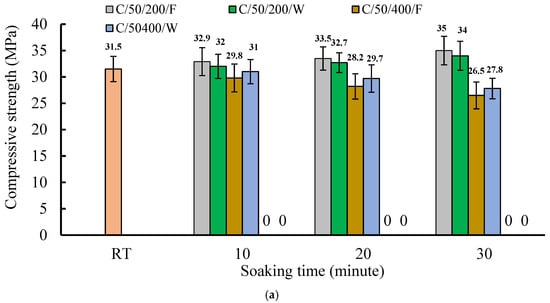
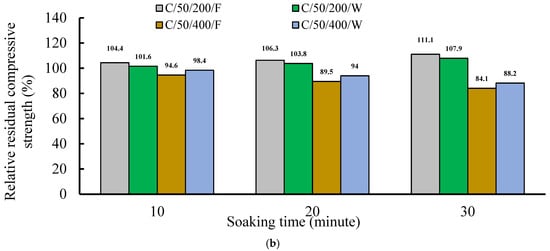
Figure 6.
(a) The residual compressive strength for C/50; (b) relative residual compressive strength for C/50.
Quantitative analysis of compressive strength at 600 °C was precluded due to the occurrence of explosive spalling in C/50 specimens approximately at 550 °C, as previously detailed in the experimental results. The differential performance in compressive strength preservation between S/50 and C/50 specimens at room temperature and at 400 °C highlights a fundamental discrepancy in matrix integrity under thermal loading. At room temperature, the higher reduction in strength observed in the C/50 mixture was mainly attributed to the greater volume fraction of EPS inclusions per cubic meter, since a constant 50% volumetric replacement of sand was applied in both systems. As indicated by the mixture proportions per cubic meter, C/50 contained a higher quantity of sand particles, leading to a larger number of EPS beads occupying a greater overall volume within the matrix. Because EPS is non–load-bearing, these inclusions acted as localized weak zones under compression, resulting in a more pronounced loss of strength compared with the S/50 counterpart. However, after exposure to elevated temperatures (≥ 400 °C), this trend was reversed, as the S/50 mixture exhibited a greater reduction in strength due to the thermal decomposition of N–A–S–H and N–(C)–A–S–H gels, which are less thermally stable than the C–S–H phases in C/50. This degradation led to more severe microstructural damage and a sharper decline in residual strength [2,12,55,56,57,62].
4.3. The Influence of Heating Duration and Cooling Methodology on the Splitting Tensile Strength of S/50 Mixture
Figure 7 presents the residual splitting tensile strength of S/50 specimens following both water and furnace cooling protocols. Under ambient conditions, the S/50 mixture developed tensile strengths of 1.06 MPa and 1.37 MPa after 7 and 28 days of curing, respectively. These values represent reductions of 33.7% and 30.1% compared to the S/0 reference mixture, which achieved 1.6 MPa and 1.96 MPa at corresponding curing intervals. This reduction is attributed to the incorporation of EPS aggregates, whose low mechanical strength and high compressibility promote microcrack formation, as confirmed through scanning electron microscopy [92,99,100]. Following exposure to 200 °C, tensile strength evolution mirrored previously observed compressive behavior. Furnace-cooled specimens demonstrated strength enhancements of 13.1%, 20.4%, and 30.6% after 10, 20, and 30 min of thermal exposure, respectively. Water-cooled specimens exhibited more moderate improvements of 8.7%, 16.1%, and 17.5% under identical conditions. These results indicate that extended thermal exposure improves tensile performance across both cooling methods, with gradually cooled specimens showing superior enhancement. The mechanical stability of fine aggregates remains largely unaffected at temperatures below 550 °C, with primary microstructural alterations occurring within the cementitious paste matrix. Although sand undergoes α-β quartz transformation at approximately 573 °C [94,101], this phase change does not substantially compromise the mechanical properties of high-strength mortar systems. While moderate temperature exposure (200 °C) yields slight improvements in indirect tensile strength, elevated temperatures (400–800 °C) produce significant deterioration in tensile performance [69].
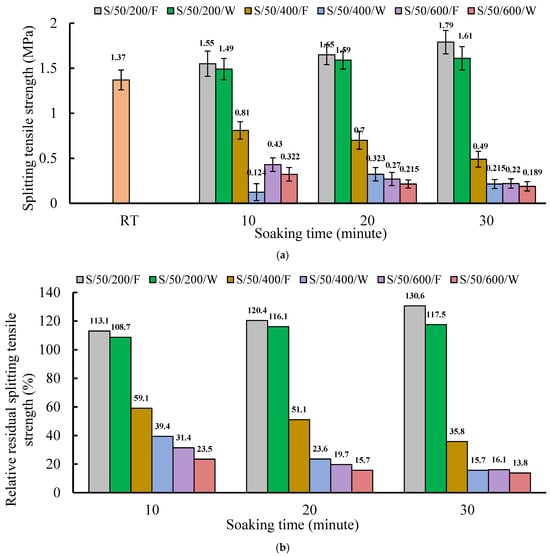
Figure 7.
(a) The results of splitting tensile strength and (b) relative residual splitting tensile strength of S/50 specimens.
Exposure to 400 °C resulted in progressive deterioration of splitting tensile strength across all tested conditions. Furnace-cooled specimens demonstrated reductions of 40.9%, 48.9%, and 64.2% following 10, 20, and 30 min of thermal exposure, respectively. Water-cooled specimens exhibited more pronounced degradation, with strength losses of 60.6%, 76.4%, and 84.3% under identical conditions. These results indicate a consistent trend of diminishing tensile performance with extended thermal exposure for both cooling methods. The superior retention of tensile strength in furnace-cooled specimens is attributed to the gradual thermal equilibration process, which minimizes thermal shock-induced microcracking. Conversely, water quenching generates substantial internal stresses due to rapid thermal contraction, resulting in accelerated microcrack propagation and consequent strength reduction [69,77]. This observation aligns with findings by Koskal et al. [76], who reported greater tensile strength deterioration in water-cooled specimens compared to air-cooled counterparts, primarily due to enhanced material brittleness following rapid cooling. The heightened sensitivity of tensile strength to thermal degradation, compared to compressive performance, reflects its greater vulnerability to microstructural defects. Flexural strength properties are particularly susceptible to microcracks and voids formed through decomposition of hydrated phases at elevated temperatures, as these defects more critically affect resistance to tensile stresses [5,92]. Exposure to 600 °C produced severe degradation in splitting tensile strength across all experimental conditions. Furnace-cooled specimens exhibited reductions of 68.6%, 80.3%, and 83.9% following 10, 20, and 30 min of thermal exposure, respectively. Water-cooled specimens demonstrated marginally greater deterioration, with strength losses of 76.5%, 84.3%, and 86.2% under equivalent soaking durations. These results establish a clear correlation between prolonged thermal exposure and diminished tensile performance, independent of cooling methodology. Contrary to the compressive behavior observed at similar temperatures, water-cooled specimens displayed slightly enhanced vulnerability to tensile strength reduction compared to furnace-cooled counterparts. This pronounced deterioration primarily stems from extensive microstructural evolution, including developed porosity through advanced gel decomposition and crystallization of high-temperature phases such as eckermannite, anorthite, and nepheline [61,69,91,92,93]. Additional mechanical degradation arises from the α-β quartz transformation in sand aggregates above 573 °C, inducing internal stresses through volumetric expansion. The minimal differential between cooling methods suggests that microstructural damage at this temperature threshold occurs predominantly during the heating phase, with the cooling mechanism exerting limited influence on the final tensile properties. The extensive matrix deterioration and pore structure development at 600 °C appear to overshadow the effects of cooling-induced stresses on the residual tensile strength.
4.4. The Influence of Heating Duration and Cooling Methodology on the Splitting Tensile Strength of C/50 Mixture
Figure 8 illustrates the residual splitting tensile strength behavior of C/50 specimens subjected to both water and furnace cooling methods. Under ambient conditions, the composite developed tensile strengths of 1.91 MPa at 7 days and 2.13 MPa following 28 days of curing. These values represent reductions of 25.4% and 36.8%, respectively, compared to the EPS-free reference mixture (C/0), attributable to the low mechanical strength and high compressibility of the incorporated EPS particles. Thermal exposure at 200 °C resulted in enhanced tensile performance across all tested conditions. Furnace-cooled specimens demonstrated strength increases of 12.2%, 22.0%, and 29.1% after 10, 20, and 30 min of exposure, respectively. Water-cooled specimens exhibited more moderate improvements of 6.1%, 14.8%, and 24.6% under identical conditions. These findings indicate a positive correlation between thermal exposure duration and tensile strength retention, with gradually cooled specimens achieving superior performance—a trend consistent with previously observed compressive strength behavior. The mechanical stability of fine aggregates remains largely unaffected at temperatures below 550 °C, with primary microstructural alterations confined to the cementitious matrix. Although sand undergoes α-β quartz transformation accompanied by volumetric expansion at approximately 573 °C [94,101], this phase change does not substantially compromise the mechanical integrity of high-strength mortar systems below this critical temperature threshold.
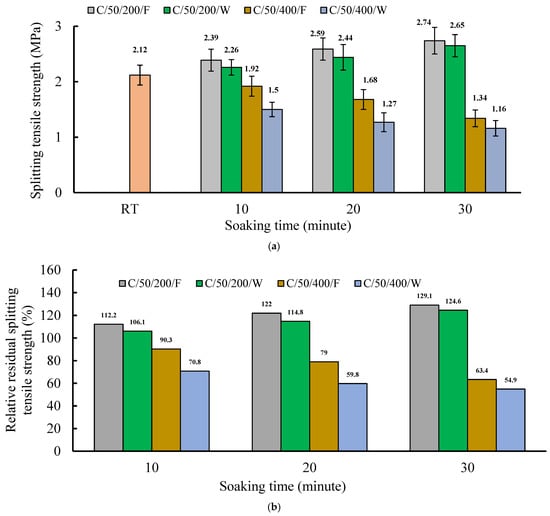
Figure 8.
(a) The results of residual splitting tensile strength and (b) relative residual splitting tensile strength of C/50 specimens.
Exposure to 400 °C resulted in progressive deterioration of splitting tensile strength for both cooling regimes. Furnace-cooled specimens exhibited reductions of 9.7%, 21.0%, and 36.6% following 10, 20, and 30 min of thermal exposure, respectively. Water-cooled specimens demonstrated more substantial degradation, with strength losses of 29.2%, 40.2%, and 45.1% under identical conditions. These results establish a clear relationship between extended thermal exposure and diminished tensile performance, with rapidly cooled specimens showing accelerated deterioration. The enhanced vulnerability of water-cooled specimens is attributed to thermal shock-induced microcracking during rapid quenching, which generates internal stresses and promotes crack propagation [69,77]. This observation aligns with findings by Koksal et al. [76], who reported greater flexural strength reduction in water-cooled specimens compared to air-cooled counterparts, primarily due to increased material brittleness following rapid thermal contraction. The heightened sensitivity of tensile strength to thermal degradation, compared to compressive performance, reflects its greater dependence on microstructural continuity. Flexural strength properties are particularly susceptible to microcracks and voids formed through decomposition of hydrated phases at elevated temperatures, as these defects more critically affect the material’s ability to resist tensile stresses [5,92]. The differential behavior between cooling methods underscores the critical role of cooling rate in determining post-thermal mechanical performance.
4.5. The Influence of Heating Duration and Cooling Methodology on the Impact Resistance of the S/50 Mixture
Impact resistance evaluation via drop-weight testing revealed that all specimens from S/50 and C/50 mixtures sustained only initial cracking (Nᵢ) without progressing to complete failure (Nf). This fracture behavior originates from the inherent brittleness of high-strength matrices, which constrains energy dissipation mechanisms and inhibits crack resistance. The minimal fracture toughness of EPS inclusions further exacerbates this condition, offering negligible resistance to crack advancement and promoting immediate structural failure upon crack initiation. Consequently, impact resistance calculations were derived exclusively from Nᵢ measurements. Figure 9 demonstrates the variation in impact resistance for S/50 specimens subjected to both cooling methods following 10, 20, and 30-min thermal exposures. Unheated specimens developed impact energies of 447.26 kN·mm and 569.24 kN·mm at 7 and 28 days, respectively. These values represent reductions of 29.0% and 28.2% compared to the EPS-free reference (S/0), which achieved 630.23 kN·mm and 792.87 kN·mm at corresponding ages. This impairment in impact performance is principally ascribed to the capacity of EPS particles to diminish fracture surface energy, thereby increasing susceptibility to crack propagation under dynamic loading conditions [102,103]. These observations corroborate findings by Zhao et al. [36] regarding the adverse influence of elevated EPS content on impact resistance. Following exposure to 200 °C, the impact resistance of S/50 specimens demonstrated enhancement analogous to the trends observed in compressive and tensile strength properties. Furnace-cooled specimens exhibited increases of 25.0%, 35.7%, and 42.0% after 10, 20, and 30 min of thermal exposure, respectively. Water-cooled specimens displayed more moderate improvements of 17.8%, 28.5%, and 35.7% under identical conditions. These results establish a positive correlation between thermal exposure duration and impact resistance retention, with gradually cooled specimens achieving superior performance—a pattern consistent with mechanical strength observations. At 400 °C, impact resistance underwent substantial deterioration. Furnace-cooled specimens demonstrated reductions of 67.9%, 78.6%, and 82.1% following 10, 20, and 30 min of exposure, respectively. Water-cooled specimens exhibited more pronounced degradation, with losses of 78.6%, 85.7%, and 89.3%. This accelerated deterioration in quenched specimens is attributed to thermal shock-induced microcracking during rapid cooling, which generates internal stresses that compromise structural integrity [62,70].
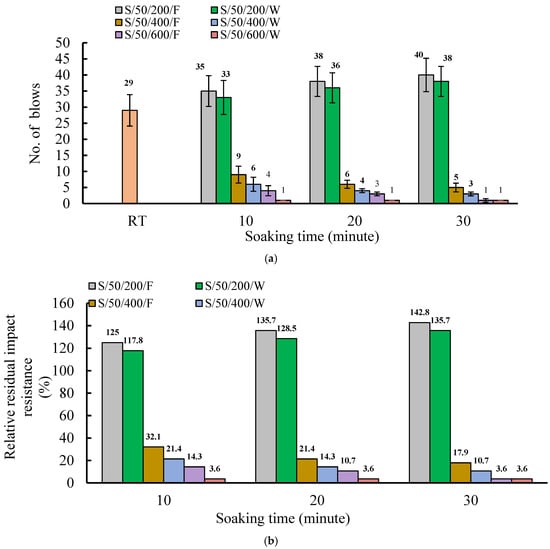
Figure 9.
(a) The results of impact resistance and (b) relative residual impact resistance of S/50 specimens.
Exposure to 600 °C resulted in near-complete loss of impact resistance. Furnace-cooled specimens showed reductions of 85.7%, 89.3%, and 96.4% after 10, 20, and 30 min, respectively. Water-cooled specimens exhibited uniform degradation of 96.4% across all exposure durations. These findings demonstrate severe impairment of impact performance under extreme thermal conditions, with water-cooled specimens consistently showing greater vulnerability than their furnace-cooled counterparts. This differential behavior aligns with previously noted patterns in both splitting tensile and compressive strength measurements, confirming the critical influence of cooling methodology on post-thermal mechanical properties.
4.6. The Influence of Heating Duration and Cooling Methodology on the Impact Resistance of the C/50 Mixture
Figure 10 presents the impact resistance characteristics of C/50 specimens subjected to both water and furnace cooling protocols following thermal exposure durations of 10, 20, and 30 min. Under ambient conditions, the composite demonstrated impact energies of 731.88 kN·mm at 7 days and 1057.16 kN·mm upon 28 days of curing. These values represent substantial reductions of 73.5% and 77.4% compared to the conventional reference mixture (C/0), which achieved 2764.88 kN·mm and 4675.90 kN·mm at corresponding ages. This significant impairment in impact performance is principally attributed to the mechanical degradation induced by EPS incorporation, which diminishes both tensile and compressive strength capacities. These observations align with findings by Zhao et al. [36], who reported pronounced reduction in impact resistance when EPS content exceeds 40% by volume. Thermal conditioning at 200 °C resulted in enhanced impact resistance retention across all tested conditions. Furnace-cooled specimens exhibited improvements of 9.6%, 26.9%, and 30.8% following 10, 20, and 30 min of exposure, respectively. Water-cooled specimens demonstrated more moderate enhancements of 3.8%, 15.4%, and 21.2% under identical parameters. These results indicate a consistent relationship between extended thermal exposure and improved impact performance, with gradually cooled specimens displaying superior energy absorption characteristics—a trend concordant with previously observed behavior in splitting tensile, compressive, and tensile strength properties.
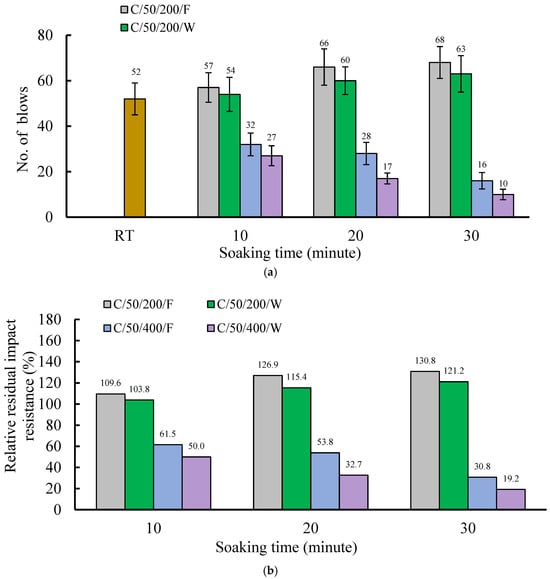
Figure 10.
(a) The results of impact resistance and (b) the relative residual impact resistance of C/50 specimens.
Exposure to 400 °C resulted in substantial deterioration of impact resistance for both cooling regimes. Furnace-cooled specimens demonstrated reductions of 38.5%, 46.2%, and 69.2% following 10, 20, and 30 min of thermal exposure, respectively. Water-cooled specimens exhibited more pronounced degradation, with losses of 50.0%, 67.3%, and 80.8% under identical conditions. These results establish a clear relationship between extended thermal exposure and diminished impact performance, with rapidly cooled specimens showing accelerated deterioration. The enhanced vulnerability of water-cooled specimens mirrors the trend observed in splitting tensile strength measurements at similar temperatures, indicating consistent material response across different mechanical testing modalities. Comparative analysis reveals significantly greater impact resistance reduction at 400 °C compared to 200 °C exposure, primarily attributable to complete EPS decomposition at higher temperatures. While intact EPS beads at 200 °C provide crack-arresting mechanisms that enhance impact resistance by mitigating deformation in low-stiffness regions [104], their thermal degradation at 400 °C eliminates this beneficial effect and creates additional void spaces that further compromise mechanical integrity. The differential performance between cooling methods underscores the critical influence of thermal history on material behavior, with rapid quenching exacerbating microstructural damage through thermal shock mechanisms. This phenomenon is particularly evident in impact resistance measurements, which show heightened sensitivity to the combined effects of EPS decomposition and cooling-induced microcracking.
4.7. Influence of Expanded Polystyrene and Binder Composition on Thermal Insulation Characteristics
Figure 11 demonstrates the comparative thermal insulation performance of S/50 and C/50 composites, highlighting the influence of binder composition. The experimental results reveal significantly enhanced thermal insulation in slag-based alkali-activated composites (S/50) compared to conventional cement-based materials (C/50) at both 200 °C and 400 °C exposure. The thermal gradient between specimen cores progressively widened with increasing target temperatures. Following 30 min of thermal exposure, core temperatures recorded 77.75 °C for S/50 versus 106.25 °C for C/50 at 200 °C, and 103 °C versus 208.5 °C, respectively, at 400 °C. Under 600 °C exposure, the S/50 specimen maintained a core temperature of 134.54 °C. The superior thermal resistance of alkali-activated systems is attributed to microcrack formation induced by high-temperature reactions in alkaline environments, as verified through SEM analysis. These microstructural features are absent in OPC-based specimens. The insulation mechanism involves phonon scattering at crack interfaces, which impedes heat transfer through solid materials. Unlike cementitious matrices, which lack efficient phonon scatterers, the fissured microstructure of alkali-activated composites effectively disrupts thermal energy propagation [105]. Although both mixtures incorporated EPS aggregates, the S/50 system demonstrated markedly improved thermal insulation performance due to the inherent thermal properties of the slag binder. This enhanced performance resulted in greater retention of unburned EPS within the alkali-activated matrix. The insulation capacity of EPS stems from its low intrinsic thermal conductivity, where the overall thermal resistance of the composite is governed by the synergistic effect between solid and gaseous phases [106]. Figure 11 further reveals thermal stability in S/50 specimens, with core temperatures remaining nearly constant 10 min after reaching 400 °C. A similar stabilization pattern was observed after 50 min of exposure at 600 °C. This thermal equilibrium phenomenon is explained by endothermic processes, including capillary water evaporation, dehydration of chemically bound water, and decomposition of hydration products, which collectively maintain stable core temperatures during thermal exposure.
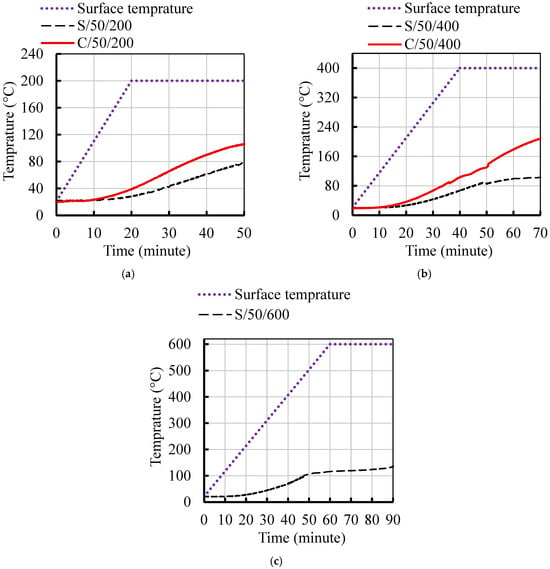
Figure 11.
Comparative time-temperature evolution profiles for surface and core regions of S/50 and C/50 specimens during thermal exposure at (a) 200 °C, (b) 400 °C, and (c) 600 °C.
4.8. Weight Loss
Figure 12 presents the mass loss characteristics of S/50 and C/50 specimens under thermal exposure and furnace cooling, resulting from the evaporation of chemically and physically bound water. For Portland cement-based composites (C/50), physically bound water evaporates below 150 °C [107], while chemically bound water within the hydration products is released at elevated temperatures exceeding 150–300 °C, depending on specific phase composition [107]. In alkali-activated systems (S/50), the temperature range of 105–300 °C facilitates the release of zeolitic and chemically bound water from N-A-S-H and C-A-S-H gels. Between 300 °C and 500 °C, structural dehydroxylation of the geopolymer framework occurs [108,109]. Both composite systems exhibited minimal mass changes at 200 °C, with progressively greater weight loss observed at 400 °C and 600 °C. These results demonstrate a consistent reduction in specimen density with increasing temperature and exposure duration. Initial dry unit weights measured 1773 kg/m3 for S/50 and 1755 kg/m3 for C/50 under ambient conditions. At 200 °C, S/50 specimens displayed mass losses of 0.54%, 0.79%, and 1.15% after 10, 20, and 30 min of exposure, respectively. C/50 specimens exhibited greater losses of 0.80%, 1.12%, and 1.45% under identical conditions, indicating superior moisture retention in the alkali-activated system attributable to its enhanced thermal insulation properties. Conversely, at 400 °C, this trend reversed with S/50 specimens showing substantially higher mass losses (6.11%, 8.42%, and 10.10%) compared to C/50 (3.99%, 4.87%, and 5.35%). This inversion reflects the more extensive decomposition of N-A-S-H and C-A-S-H gels in alkali-activated systems relative to C-S-H degradation in Portland cement matrices. At 600 °C, mass losses for S/50 specimens reached 11.66%, 12.79%, and 14.10%, demonstrating progressive deterioration of the geopolymer framework with extended thermal exposure.
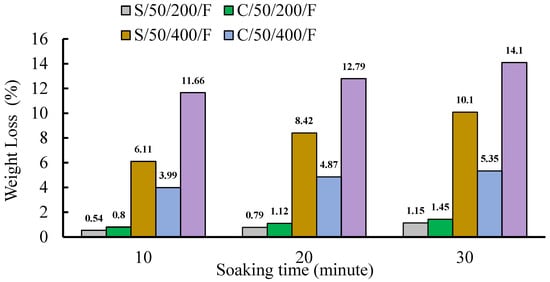
Figure 12.
Comparative mass loss behavior of S/50 and C/50 cubic specimens under thermal loading conditions.
4.9. Explosive Spalling Potential and Visual Characteristics
This section examines the influence of elevated temperatures (200 °C, 400 °C, and 600 °C) and cooling techniques (furnace and water quenching) on the explosive spalling susceptibility of C/50 and S/50 specimens across 10, 20, and 30-min exposure intervals. Explosive spalling denotes the violent detachment of surface material under thermal loading [6], a phenomenon particularly prevalent in high-strength and lightweight high-strength conventional concretes [3,5,6]. Previous investigations by Aslani and Ma [6] documented considerable explosive spalling in high-strength lightweight self-compacting concrete at 300 °C following one-hour exposure at a 5 °C/min heating rate. In the present investigation, C/50 specimens demonstrated complete resistance to explosive spalling at 400 °C across all exposure durations and cooling methods. The incorporation of EPS aggregates effectively counteracted the spalling tendency typically associated with high-strength, low-permeability matrices at this temperature threshold. This protective mechanism is ascribed to the decomposition of EPS beads, which generates supplementary porosity and microcracking within the cementitious matrix—functioning analogously to polypropylene fiber disintegration. These void networks facilitate pressure release from vaporized moisture, thereby mitigating explosive spalling risk.
Conversely, all C/50 specimens exhibited severe spalling approximately at 550 °C (after ~55 min of furnace heating) during 600 °C exposure trials. The violence of these failures precluded accurate core temperature measurement and resulted in specimen fragmentation into 1–4 cm long and 0.8–3.5 cm thick segments, with approximately 65% of the original volume remaining intact (Figure 13). This catastrophic failure is attributed to synergistic effects of rapid heating rate, inherently low matrix permeability, and the high air volume fraction (~95%) inherent to EPS inclusions. These factors collectively promoted critical internal vapor pressure development [98], generating thermal stresses that surpassed the matrix’s tensile capacity and culminating in explosive failure. The incorporation of EPS aggregates within S/50 specimens did not induce detrimental effects from elevated internal vapor pressure, notwithstanding the material’s high inherent air content (~95% by volume). Accordingly, S/50 composites demonstrated complete resistance to explosive spalling at temperatures up to 600 °C across all tested exposure durations and cooling methodologies. This superior performance is ascribed to the innate nano-porosity within the material’s three-dimensional aluminosilicate framework, which facilitates the egress and evaporation of both physically and chemically bound water [2,110,111,112]. Furthermore, the pre-existing microcrack network, formed during mixing due to rapid reaction kinetics and high alkalinity, enhances void connectivity within the alkali-activated matrix at ambient temperature. This interconnected microstructural network promotes efficient vapor transmission during thermal exposure, thereby mitigating internal pressure accumulation and preventing explosive failure [92,99,100]. Visually, neither C/50 nor S/50 specimens developed visible surface cracking following exposure to 200 °C under either cooling regime. At elevated temperatures, however, both composite types exhibited surface fissuring across all soaking durations, attributable to EPS vaporization near external surfaces (Figure 13 and Figure 14). The pivotal determinant of spalling resistance extends beyond mere porosity to encompass pore network connectivity and structural stability. The LWAS (S/50) geopolymer matrix possesses an intrinsically nanoporous structure with a stable, interconnected microcrack network established during curing. This architecture provides continuous vapor diffusion pathways that dissipate internal pressure effectively, with EPS augmentation merely supplementing this pre-existing system. Conversely, the LWPC (C/50) matrix is characterized by high density and low permeability. The macroscopic, isolated voids resulting from EPS decomposition function as pressurized cavities rather than pressure-release channels. When vapor pressure within these discrete voids surpasses the tensile capacity of the surrounding dense cement paste, catastrophic failure ensues.

Figure 13.
Visual characterization of LWPC specimens following thermal treatment: (a) furnace-cooled specimen; (b) water-cooled specimen.
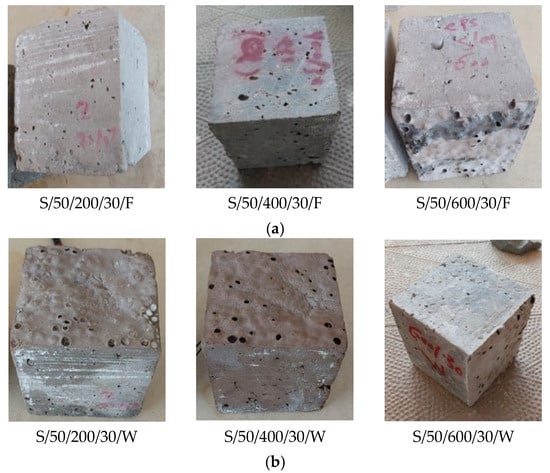
Figure 14.
Visual characterization of LWAS specimens following thermal treatment: (a) furnace-cooled specimen; (b) water-cooled specimen.
4.10. SEM Analysis
Scanning electron microscopy (SEM) coupled with energy-dispersive X-ray spectroscopy (EDS) was employed to evaluate microstructural evolution in S/50 and C/50 composites following exposure to varying thermal conditions and cooling regimes. Figure 15 presents analyzed specimens, including S/0, S/50-400-10-F, S/50-400-10-W, C/0, C/50-400-10-F, and C/50-400-10-W. It should be noted that the magnifications of the SEM images vary among the analyzed specimens; therefore, the comparison is qualitative rather than quantitative. Figure 15a displays the microstructure of the S/0 reference mixture. Figure 15a displays the microstructure of the S/0 reference mixture at ambient temperature, revealing characteristic microcracking attributable to rapid polymerization kinetics and high alkalinity during mixing. These microcracks enhance pore network connectivity in alkali-activated systems, promoting vapor migration and mitigating explosive spalling risk at elevated temperatures. The low water-to-binder ratio (35%) additionally resulted in partially reacted slag particles. Significant microstructural alterations are evident in S/50 specimens after 400 °C exposure (Figure 15b), including propagation of existing fractures and nucleation of new microcracks induced by thermal shrinkage and hydrate decomposition. These changes correspond to matrix coarsening and explain the observed reduction in residual compressive strength at 400 °C and 600 °C [91]. Notably, the water-cooled S/50-400-10-W specimen (Figure 15c) exhibits a denser morphology compared to its furnace-cooled counterpart, consistent with its superior residual compressive performance. EPS incorporation introduced additional voids and microcracks from bead decomposition, accompanied by carbonaceous residues. The identification of pores, cracks, and gel types was guided by their morphological features and EDS results. Pores appeared as dark voids, cracks as linear fissures, and gel differentiation (C–S–H vs. C–A–S–H) was verified through Ca/Si ratios rather than visual morphology.
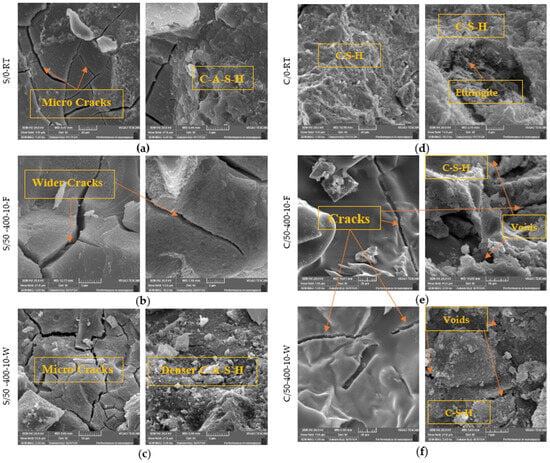
Figure 15.
The SEM images of S/50 and C/50 specimens at different magnifications (a) S/0-RT, (b) S/50-400-10-F, (c) S/50-400-10-W, (d) C/0-RT, (e) C/50-400-10-F, (f) C/50-400-10-W.
The C/0 reference mixture (Figure 15d) at 25 °C displays microcrystalline and amorphous calcium silicate hydrate (C-S-H) phases alongside portlandite crystals and pore structures, without evident microcracking. It should be noted that C–S–H gels dominate the OPC-based matrices, while C–A–S–H gels characterize the slag-based geopolymer systems, consistent with their respective hydration and geopolymerization mechanisms. Figure 15e,f illustrate that EPS integration in cementitious composites (C/50-400-10-F and C/50-400-10-W) generated supplementary voids and fracture networks from EPS disintegration. These defects represent potential failure initiation sites within the composite system. Furnace-cooled specimens exhibited greater porosity due to prolonged thermal exposure during slow cooling, while water-quenched specimens demonstrated denser microstructures from rehydration processes, correlating with their enhanced mechanical performance. Moreover, the incorporation of EPS beads, while effective in reducing density and mitigating explosive spalling, inherently increases matrix porosity and leads to a reduction in strength. The microstructural behavior observed in LWAS can be further explained through recent fundamental studies on the evolution of hydrated aluminosilicate gels. These studies revealed that nanoscale phase separation and topological relaxation within the gel structure facilitate internal stress dissipation and controlled vapor release, which align with the experimentally observed spalling resistance in LWAS [113,114]. Moreover, long-term investigations on geopolymer carbonation and gel stability have confirmed the persistence of these structural features under extended thermal exposure, supporting the enhanced durability and stability of alkali-activated systems [115]. To address this trade-off, future research should consider hybrid reinforcement approaches—such as incorporating micro steel fibers, basalt fibers, or nano-silica additives—to enhance matrix continuity and compensate for EPS-induced voids. Such strategies represent promising future work toward achieving a balanced lightweight–high-strength geopolymer system.
Considering the atomic percentages from the EDS Table 5, the following were revealed:
- C/0-RT (Cement Reference at Room Temperature):
- ◦
- Ca/Si = 33.42/10.01 ≈ 3.34
- ◦
- This very high Ca/Si ratio is classic for conventional Portland cement, dominated by high-lime C-S-H gel and the presence of portlandite (Ca(OH)2), which is highly susceptible to decomposition at elevated temperatures.
- S/0-RT (Slag Reference at Room Temperature):
- ◦
- Ca/Si = 6.84/4.98 ≈ 1.37
- ◦
- (Ca+Al)/Si = (6.84 + 1.83)/4.98 ≈ 1.74
- ◦
- This lower ratio confirms the formation of a calcium aluminosilicate hydrate (C-A-S-H) gel, typical of alkali-activated slag. This gel is more cross-linked and thermally stable than the high-lime C-S-H found in cement.
- S/50-400-10-F (Slag+EPS, Furnace Cooled):
- ◦
- Ca/Si = 14.48/10.62 ≈ 1.36
- ◦
- (Ca+Al)/Si = (14.48 + 4.20)/10.62 ≈ 1.76
- ◦
- The ratios remain remarkably similar to the room-temperature S/0 sample. This indicates a high degree of stability in the C-A-S-H gel structure even after exposure to 400 °C. The gel has not significantly decomposed or reconfigured into weaker crystalline phases.
- S/50-400-10-W (Slag+EPS, Water Cooled):
- ◦
- Ca/Si = 16.96/8.13 ≈ 2.09
- ◦
- (Ca+Al)/Si = (16.96 + 9.07)/8.13 ≈ 3.20
- ◦
- The increase in these ratios, especially the significant jump in Al content, suggests a potential rehydration and re-precipitation process during water quenching. The rapid cooling may have allowed dissolved species to form new, dense reaction products that fill cracks, explaining the higher residual compressive strength observed in water-cooled slag specimens.
- C/50-400-10-F (Cement+EPS, Furnace Cooled):
- ◦
- Ca/Si = 34.93/9.65 ≈ 3.62
- ◦
- This ratio is even higher than the cement reference, likely due to the decomposition of other phases (like ettringite and C-S-H itself), leaving behind a relative enrichment of lime (CaO) and other calcium-rich compounds. This signifies severe degradation of the binding matrix.
- C/50-400-10-W (Cement+EPS, Water Cooled):
- ◦
- Ca/Si = 13.51/7.71 ≈ 1.75
- ◦
- The dramatic drop in the Ca/Si ratio and the very high Carbon (C) content (25.41%) is anomalous and likely an artifact of the measurement. The high C signal suggests that the EDS scan may have been performed on a piece of charred EPS residue or a carbon-coated pore, rather than on the cementitious gel itself. Therefore, this specific data point may not be representative of the bulk matrix chemistry and should be interpreted with caution.

Table 5.
EDS Elemental Atomic Ratios (atom. %).
Table 5.
EDS Elemental Atomic Ratios (atom. %).
| Sample | O | Na | Ca | Fe | Si | C | Al | Mg | K | Cl | Cr | P | Ti |
|---|---|---|---|---|---|---|---|---|---|---|---|---|---|
| S/0-RT | 56.57 | 17.87 | 6.84 | 4.5 | 4.98 | 5.76 | 1.83 | 1.45 | 0.21 | - | - | - | - |
| S/50-400-10-F | 54.25 | 5.44 | 14.48 | 0.23 | 10.62 | 8.05 | 4.2 | 2.21 | 0.25 | 0.13 | 0.07 | 0.08 | - |
| S/50-400-10-W | 40.93 | 3.41 | 16.96 | 2.64 | 8.13 | 11.11 | 9.07 | 0.95 | 0.6 | 0.72 | 0.16 | 0.44 | - |
| C/0-RT | 54.84 | 0.16 | 33.42 | 0.82 | 10.01 | - | 0.75 | - | - | - | - | - | - |
| C/50-400-10-F | 43.16 | 1.04 | 34.93 | 1.74 | 9.65 | 6.6 | 1.79 | 0.49 | 0.26 | 0.01 | 0.14 | 0.09 | - |
| C/50-400-10-W | 36.3 | 2.54 | 13.51 | 2.56 | 7.71 | 25.41 | 1.95 | 2.22 | 0.32 | 0.09 | 0.01 | 0.07 | 0.18 |
Moreover, the EDS results provide a microchemical explanation for the macroscopic behaviors observed throughout the study:
- Superior Spalling Resistance of LWAS (S/50): The stable, low Ca/Si C-A-S-H gel in the slag system creates a nanoporous and finely cracked microstructure (as seen in SEM). This structure provides continuous pathways for steam pressure to escape. The EDS confirms that this gel remains chemically intact at 400 °C, meaning the pore network remains functional under thermal stress. In contrast, the cement paste’s high Ca/Si gel breaks down irreversibly, and the voids from EPS are isolated, leading to pressure build-up and explosive spalling.
- Mechanical Performance Divergence: The stability of the C-A-S-H gel in S/50 explains its more gradual strength loss. Even at 400 °C, the gel structure, while coarsened, is still present and providing some binding force. The cementitious C-S-H gel in C/50, with its inherent thermal instability, undergoes rapid and catastrophic breakdown, leading to swift mechanical degradation even before the point of spalling. The potential for rehydration in water-cooled S/50 (hinted at by the changed ratios) directly correlates with its better retention of compressive strength compared to its furnace-cooled counterpart.
- Role of EPS: The EDS results show that the fundamental difference lies in the binder, not the EPS. In both systems, EPS decomposes and creates pores. However, the interaction of these pores with the matrix is different. In the stable, micro-cracked slag matrix, EPS pores simply integrate into the existing escape network. In the dense, impermeable cement matrix, they become isolated defects that amplify internal stresses.
5. Conclusions
Based on the experimental findings of this investigation, the following conclusions can be drawn:
- Superior Spalling Resistance: The lightweight alkali-activated slag composite (LWAS-S/50) demonstrated complete resistance to explosive spalling up to 600 °C due to its inherent nanoporous microstructure, which provides a pervasive network for vapor pressure release. Conversely, the lightweight cementitious composite (LWPC-C/50) experienced catastrophic explosive spalling at approximately 550 °C, proving that the macro-voids formed by expanded polystyrene (EPS) decomposition in an OPC matrix are insufficient to prevent failure under rapid heating.
- Divergent Mechanical Performance: Both LWAS and LWPC mixtures exhibited strength enhancement at 200 °C due to continued hydration and pore structure densification. However, their performance diverged significantly at higher temperatures. LWAS underwent a more gradual and predictable strength reduction (e.g., ~68% compressive strength loss at 400 °C after 30 min), whereas LWPC degraded rapidly before its eventual failure. Water quenching was generally beneficial for residual compressive strength but detrimental to tensile and impact properties due to induced thermal shock.
- Thermal Insulation Trade-off: The incorporation of EPS beads significantly improved thermal insulation, particularly in the LWAS, where the core temperature was reduced by 105.5 °C at 400 °C. However, this benefit comes with a trade-off, as the voids left by decomposed EPS contribute to increased porosity and accelerated mechanical degradation at extreme temperatures.
- Microstructural Validation: Microstructural analysis confirmed that the stable, interconnected microcrack network in the slag-based matrix is the fundamental factor enabling its spalling resistance. In contrast, EPS decomposition in the cement matrix creates unstable, isolated voids that exacerbate thermal stresses and lead to failure.
- Practical Design Implications: Alkali-activated slag composites (LWAS) are recommended for applications requiring fire resistance up to 600 °C, though their high-temperature strength loss necessitates the use of hybrid fiber reinforcement for structural purposes. Ordinary Portland cement composite with EPS (LWPC) are suitable only for applications where the maximum service temperature is guaranteed to remain below 400 °C.
- The cooling method also influenced the results: furnace-cooled specimens showed higher strength at 200 °C due to gradual stress release, while water-quenched ones retained slightly more strength at 400 °C owing to partial rehydration. At 600 °C, this effect became negligible as thermal damage prevailed.
- Alkali-activated slag composites showed promising potential for practical use in fire-resistant panels, tunnel linings, and façade claddings due to their spalling-proof and thermally stable behavior.
Future work should include further studies examining the elastic modulus, flexural performance, and long-term durability under thermal exposure to gain deeper insight into the effects of EPS beads. Additionally, research is needed to propose and evaluate alternative reinforcement strategies to compensate for the strength reduction at high temperatures.
Author Contributions
Conceptualization, A.Y.F.A., M.K.I., S.A.A., P.Y. and M.S.E.-F.; Methodology, A.Y.F.A., M.K.I., S.A.A., P.Y. and M.S.E.-F.; Validation, A.Y.F.A., M.K.I., S.A.A., P.Y. and M.S.E.-F.; Formal analysis, A.Y.F.A., M.K.I., S.A.A., P.Y. and M.S.E.-F.; Investigation, A.Y.F.A., M.K.I., S.A.A., P.Y. and M.S.E.-F.; Data curation, A.Y.F.A., M.K.I., S.A.A., P.Y. and M.S.E.-F.; Writing—original draft, A.Y.F.A.; Writing—review and editing, M.K.I., S.A.A., P.Y. and M.S.E.-F.; Visualization, A.Y.F.A., M.K.I., S.A.A., P.Y. and M.S.E.-F.; Supervision, S.A.A. and M.S.E.-F. All authors have read and agreed to the published version of the manuscript.
Funding
This research received no external funding.
Data Availability Statement
The original contributions presented in this study are included in the article. Further inquiries can be directed to the corresponding authors.
Conflicts of Interest
The authors declare no conflict of interest.
References
- Mindess, S.; Young, J.F.; Darwin, D. Concrete, 2nd ed.; Prentice Hall: Upper Saddle River, NJ, USA, 2003. [Google Scholar]
- Lahoti, M.; Tan, K.H.; Yang, E.-H. A critical review of geopolymer properties for structural fire-resistance applications. Constr. Build. Mater. 2019, 221, 514–526. [Google Scholar] [CrossRef]
- Phan, L.T. High-strength concrete at high temperature: An overview. In Proceedings of the Sixth International Symposium on the Utilization of High Strength/High Performance, Concrete, Leipzig, Germany, 23 June 2022; Konig, G., Dehn, F., Faust, T., Eds.; Volume 1, pp. 501–518. [Google Scholar]
- Poon, C.-S.; Azhar, S.; Anson, M.; Wong, Y.-L. Comparison of the strength and durability performance of normal- and high-strength pozzolanic concretes at elevated temperatures. Cem. Concr. Res. 2001, 31, 1291–1300. [Google Scholar] [CrossRef]
- Matesová, D.; Bonen, D.; Shah, S.P. Factors affecting the resistance of cementitious materials at high temperatures and medium heating rates. Mater. Struct. 2006, 39, 921–935. [Google Scholar] [CrossRef]
- Aslani, F.; Ma, G. Normal and High-Strength Lightweight Self-Compacting Concrete Incorporating Perlite, Scoria, and Polystyrene Aggregates at Elevated Temperatures. J. Mater. Civ. Eng. 2018, 30, 04018328. [Google Scholar] [CrossRef]
- Zhao, J.; Zheng, J.-J.; Peng, G.-F.; Sun, P.-S. Spalling and cracking modelling of high-performance concrete exposed to elevated temperatures. Mag. Concr. Res. 2017, 69, 1276–1287. [Google Scholar] [CrossRef]
- Ali, M.B.; Saidur, R.; Hossain, M.S. A review on emission analysis in cement industries. Renew. Sustain. Energy Rev. 2011, 15, 2252–2261. [Google Scholar] [CrossRef]
- Batran, T.Z.; Ismail, M.K.; Serag, M.I.; Ragab, A.M. Cement-Free Geopolymer Paste: An Eco-Friendly Adhesive Agent for Concrete and Masonry Repairs. Buildings 2024, 14, 3426. [Google Scholar] [CrossRef]
- Meyer, C. The greening of the concrete industry. Cem. Concr. Compos. 2009, 31, 601–605. [Google Scholar] [CrossRef]
- Fernández-Jiménez, A.M.; Palomo, A.; López-Hombrados, C. Engineering properties of alkali-activated fly ash concrete. ACI Mater. J. 2006, 103, 106–112. [Google Scholar] [CrossRef] [PubMed]
- Zhang, H.; Li, L.; Yuan, C.; Wang, Q.; Sarker, P.K.; Shi, X. Deterioration of ambient-cured and heat-cured fly ash geopolymer concrete by high temperature exposure and prediction of its residual compressive strength. Constr. Build. Mater. 2020, 262, 120924. [Google Scholar] [CrossRef]
- Wang, A.; Zheng, Y.; Zhang, Z.; Liu, K.; Li, Y.; Shi, L.; Sun, D. The durability of alkali-activated materials in comparison with ordinary Portland cements and concretes: A review. Engineering 2020, 6, 695–706. [Google Scholar] [CrossRef]
- Provis, J.L. Cement and concrete research alkali-activated materials. Cement Concr. Res. 2018, 114, 40–48. [Google Scholar] [CrossRef]
- Ali, A.; Ahmed, S.A.; El-Feky, M. Alkali-activated concrete with expanded polystyrene: A lightweight, high-strength solution for fire resistance and explosive protection. J. Build. Eng. 2025, 99, 111648. [Google Scholar] [CrossRef]
- Amer, I.; Kohail, M.; El-Feky, M.S.; Rashad, A.; Khalaf, M.A. Enhancing the Resistance to Elevated Temperature of Alkali-Activated Slag Concrete: A Comparative Study of the Role of Polypropylene Fibers. J. Mater. Civ. Eng. 2025, 37, 04024476. [Google Scholar] [CrossRef]
- Amer, I.; Kohail, M.; El-Feky, M.S.; Rashad, A.; Khalaf, M.A. Realistic Evaluation of Reinforcement Bond Strength in Alkali-Activated Slag Concrete Exposed to Elevated Temperature. Int. J. Concr. Struct. Mater. 2023, 17, 36. [Google Scholar] [CrossRef]
- Wetzel, A.; Middendorf, B. Influence of silica fume on properties of fresh and hardened ultra-high-performance concrete based on alkali-activated slag. Cem. Concr. Compos. 2019, 100, 53–59. [Google Scholar] [CrossRef]
- Albitar, M.; Ali, M.M.; Visintin, P.; Drechsler, M. Durability evaluation of geopolymer and conventional concretes. Construct. Build Mater. 2017, 136, 374–385. [Google Scholar] [CrossRef]
- Albidah, A.; Alqarni, A.S.; Abbas, H.; Almusallam, T.; Al-Salloum, Y. Behavior of Metakaolin-Based geopolymer concrete at ambient and elevated temperatures. Construct. Build Mater. 2022, 317, 125910. [Google Scholar] [CrossRef]
- Ahmed, S.A.; Ebrahem, E.; El-amir, A.A.M. Developing lightweight structural concrete with enhanced thermal and durability properties through nano-silica and expanded polystyrene integration. Sci. Rep. 2025, 15, 27100. [Google Scholar] [CrossRef]
- Al-Jabri, K.S.; Hago, A.W.; Al-Nuaimi, A.S.; Al-Saidy, A.H. Concrete blocks for thermal insulation in hot climate. Cem. Concr. Res. 2005, 35, 1472–1479. [Google Scholar] [CrossRef]
- Bilodeau, A.; Kodur, V.K.R.; Hoff, G.C. Optimization of the type and amount of polypropylene fibres for preventing the spalling of lightweight concrete subjected to hydrocarbon fire. Cem. Concr. Compos. 2004, 26, 163–174. [Google Scholar] [CrossRef]
- Al-Khaiat, H.; Haque, M.N. Effect of initial curing on early strength and physical properties of lightweight concrete. Cem. Concr. Res. 1998, 28, 859–866. [Google Scholar] [CrossRef]
- Ahmed, S.A.; Ebrahem, E.; El-Feky, M.S. Achieving sustainable performance: Synergistic effects of nano-silica and recycled expanded polystyrene in lightweight structural concrete. Sci. Rep. 2024, 14, 26648. [Google Scholar] [CrossRef]
- Ali, A.Y.F.; Ahmed, S.A.; Youssef, P.; Abdel-Wahab, A.M.; El-Feky, M.S. Fire performance and spalling mitigation in high-strength and eps-modified mortars under transient thermal exposure. Sci. Rep. 2025, 15, 32497. [Google Scholar] [CrossRef]
- Dixit, A.; Pang, S.D.; Kang, S.H.; Moon, J. Lightweight structural cement composites with expanded polystyrene (EPS) for enhanced thermal insulation. Cem. Concr. Compos. 2019, 102, 185–197. [Google Scholar] [CrossRef]
- International Energy Agency. Transition to Sustainable Buildings; International Energy Agency: Paris, France, 2013. [Google Scholar]
- Ozawa, M.; Parajuli, S.S.; Uchida, Y.; Zhou, B. Preventive effects of polypropylene and jute fibers on spalling of UHPC at high temperatures in combination with waste porous ceramic fine aggregate as an internal curing material. Constr. Build. Mater. 2019, 206, 219–225. [Google Scholar] [CrossRef]
- Liu, J.C.; Tan, K.H. Mechanism of PVA fibers in mitigating explosive spalling of engineered cementitious composite at elevated temperature. Cem. Concr. Compos. 2018, 93, 235–245. [Google Scholar] [CrossRef]
- Missemer, L.; Ouedraogo, E.; Malecot, Y.; Clergue, C.; Rogat, D. Fire spalling of ultra-high performance concrete: From a global analysis to microstructure investigations. Cem. Concr. Res. 2019, 115, 207–219. [Google Scholar] [CrossRef]
- Lee, G.; Han, D.; Han, M.C.; Han, C.G.; Son, H.J. Combining polypropylene and nylon fibers to optimize fiber addition for spalling protection of high-strength concrete. Constr. Build. Mater. 2012, 34, 313–320. [Google Scholar] [CrossRef]
- Cai, R.; Liu, J.-C.; Ye, H. Spalling Prevention of Ultrahigh-Performance Concrete: Comparative Effectiveness of Polyethylene Terephthalate and Polypropylene Fibers. J. Mater. Civ. Eng. 2021, 33, 04021344. [Google Scholar] [CrossRef]
- Short, A.; Kinniburgh, W. Lightweight Concrete, 3rd ed.; Applied Science Publishers: London, UK, 1978. [Google Scholar]
- Sussman, V. Lightweight plastic–aggregate concrete. J. Am. Concr. Inst. Proc. 1975, 72, 321–323. [Google Scholar]
- Zhao, D.; Xu, J.; Bai, E. Study on toughening effect in EPS concrete. Appl. Mech. Mater. 2012, 105–107, 1717–1722. [Google Scholar] [CrossRef]
- Bažant, Z.P.; Thonguthai, W. Pore pressure in heated concrete walls: Theoretical prediction. Mater. Struct. 1979, 31, 67–76. [Google Scholar] [CrossRef]
- Handoo, S.K.; Agarwal, S.; Agarwal, S.K. Physicochemical, mineralogical, and morphological characteristics of concrete exposed to elevated temperatures. Cem. Concr. Res. 2002, 32, 1009–1018. [Google Scholar] [CrossRef]
- Castillo, C. Effect of transient high temperature on High-Strength Concrete. ACI Mater. J. 1990, 87, 47–53. [Google Scholar] [CrossRef]
- Pulkit, U.; Adhikary, S.D. Effect of micro-structural changes on concrete properties at elevated temperature: Current knowledge and outlook. Struct. Concr. 2022, 23, 1995–2014. [Google Scholar] [CrossRef]
- Furumura, F.; Abe, T.; Shinohara, Y. Mechanical Properties of High Strength Concrete at High Temperatures. In Proceedings of the Fourth Weimar Workshop on High strength Concrete: Material Properties and Design, Weimar, Germany, 4–5 October 1995; Hochschule für Architektur und Bauwesen (HAB): Weimar, Germany, 1995. [Google Scholar]
- Phan, L.T.; Carino, N.J. Review of mechanical properties of HSC at elevated temperature. J. Mater. Civ. Eng. Am. Soc. Civ. Eng. 1998, 10, 58–64. [Google Scholar] [CrossRef]
- Phan, L.T.; Carino, N.J. Mechanical Properties of High Strength Concrete at Elevated Temperatures; NISTIR 6726; Building and Fire Research Laboratory, National Institute of Standards and Technology: Gaithersburg, MD, USA, 2001. [Google Scholar]
- Phan, L.T.; Carino, N.J. Effects of test conditions and mixture proportions on behavior of high_strength concrete exposed to high temperatures. ACI Mater. J. Am. Concr. Inst. 2002, 99, 54–66. [Google Scholar]
- Saeed, N.M.; Omer, B.; Jamal, A.S.; Dheyaaldin, M.H. Performance of cement mortar modified with GGBFS at elevated temperatures with various w/b ratios and superplasticizer dosages. Constr. Build. Mater. 2023, 368, 130493. [Google Scholar] [CrossRef]
- Cu, M.S.; Zturan, T.O. Effect of elevated temperatures on the mechanical properties of concrete. Procedia Struct. Integr. 2019, 14, 384–394. [Google Scholar] [CrossRef]
- Badawy, A.H.; El-hadad, A.S.; El-Hariri, M.O.R.; Gamal, A.A.; El-Gammal, M.A.; El-Feky, M.S. Enhancing Post-Fire Residual Performance of Concrete: A Comprehensive study on the Synergistic Effects of Multiwalled Carbon Nanotubes and Nano Clay at Elevated Temperatures. Egypt. J. Chem. 2025, 68, 325–342. [Google Scholar] [CrossRef]
- Djaknoun, S.; Ouedraogo, E.; Benyahia, A.A. Characterisation of the behaviour of high performance mortar subjected to high temperatures. Constr. Build. Mater. 2012, 28, 176–186. [Google Scholar] [CrossRef]
- Sullivan, P.J. A probabilistic method of testing for the assessment of deterioration and explosive spalling of high strength concrete beams in flexure at high temperature. Cem. Concr. Compos. 2004, 26, 155–162. [Google Scholar] [CrossRef]
- Khoury, G.A.; Grainger, B.N.; Sullivan, P.J. Transient thermal strain of concrete: Literature review, conditions within specimen and behavior of individual constituents. Mater. Struct. 1985, 37, 131–144. [Google Scholar] [CrossRef]
- Phan, L.T. Fire Performance of High-Strength Concrete: A Report of the State-of-the-Art; NISTIR 5934; Building and Fire Research Laboratory, National Institute of Standards and Technology: Gaithersburg, MD, USA, 1996; p. 105. [Google Scholar]
- Ta, H. High Strength Concrete, Phase 3. SP6 Fire Resistance-Report 6.2, Spalling Reduction through Material Design; STF70 F92156; SINTEF: Trondheim, Norway, 1992. [Google Scholar]
- Sanjayan, G.; Stocks, L.J. Spalling of high-strength silica fume concrete in fire. ACI Mat. J. 1993, 90, 170–174. [Google Scholar]
- Phan, L.T.; Lawson, J.R.; Davis, F.L. Effects of elevated temperature exposure on heating characteristics, spalling and residual properties of high performance concrete. Mat. Struct. 2001, 34, 83–91. [Google Scholar] [CrossRef]
- Çelikten, S.; Sarıdemir, M.; Deneme, İ.Ö. Mechanical and microstructural properties of alkali-activated slag and slag+ fly ash mortars exposed to high temperature. Constr. Build. Mater. 2019, 217, 50–61. [Google Scholar] [CrossRef]
- Guerrieri, M.; Sanjayan, J.; Collins, F. Residual compressive behavior of alkali_activated concrete exposed to elevated temperatures. Fire Mater. 2009, 33, 51–62. [Google Scholar] [CrossRef]
- Kong, D.L.; Sanjayan, J.G. Damage behaviour of geopolymer composites exposed to elevated temperatures. Cem. Concr. Compos. 2008, 30, 986–991. [Google Scholar] [CrossRef]
- Abdulkareem, O.A.; Al Bakri, A.M.; Kamarudin, H.; Nizar, I.K.; Saif, A.E.A. Effects of elevated temperatures on the thermal behaviour and mechanical performance of fly ash geopolymer paste, mortar and lightweight concrete. Constr. Build. Mater. 2014, 50, 377–387. [Google Scholar] [CrossRef]
- Sarker, P.K.; Mcbeath, S. Fire endurance of steel reinforced fly ash geopolymer concrete elements. Constr. Build. Mater. 2015, 90, 91–98. [Google Scholar] [CrossRef]
- Lee, N.K.; Koh, K.T.; An, G.H.; Ryu, G.S. Influence of binder composition on the gel structure in alkali activated fly ash/slag pastes exposed to elevated temperatures. Ceram. Int. 2017, 43, 2471–2480. [Google Scholar] [CrossRef]
- Cai, R.; Wu, T.; Fu, C.; Ye, H. Thermal degradation of potassium-activated ternary slag-fly ash-silica fume binders. Constr. Build. Mater. 2022, 320, 126304. [Google Scholar] [CrossRef]
- Sarker, P.K.; Kelly, S.; Yao, Z. Effetc of fire exposure on cracking, spalling and residual strength of fly ash geopolymer concrete. Mater Des. 2014, 63, 584–592. [Google Scholar] [CrossRef]
- Zhao, R.; Sanjayan, J. Geopolymer and Portland cement concretes in simulated fire. Mag. Concr. Res. 2011, 63, 163–173. [Google Scholar] [CrossRef]
- Kong, D.L.; Sanjayan, J.G. Effect of elevated temperatures on geopolymer paste, mortar and concrete. Cem. Concr. Res. 2010, 40, 334–339. [Google Scholar] [CrossRef]
- Shaikh, F.U.A.; Vimonsatit, V. Compressive strength of fly ash based geopolymer concrete at elevated temperatures. Fire Mater. 2015, 39, 174–188. [Google Scholar] [CrossRef]
- Shaikh, F.U.A.; Hosan, A. Mechanical properties of steel fibre reinforced geopolymer concretes at elevated temperatures. Constr. Build. Mater. 2016, 114, 15–28. [Google Scholar] [CrossRef]
- Hertz, K.D. Concrete strength for fire safety design. Mag. Concr. Res. 2005, 57, 445–453. [Google Scholar] [CrossRef]
- Aydin, S. Development of a high-temperature-resistant mortar by using slag and pumice. Fire Saf. J. 2008, 43, 610–617. [Google Scholar] [CrossRef]
- Shaikh, F.U.A.; Vimonsatit, V. Effect of cooling methods on residual compressive strength and cracking behavior of fly ash concretes exposed at elevated temperatures. Fire Mater. 2016, 40, 335–350. [Google Scholar] [CrossRef]
- Shoaib, M.M.; Ahmed, S.A.; Balaha, M.M. Effect of fire and cooling mode on the properties of slag mortars. Cem. Concr. Res. 2001, 31, 1533–1538. [Google Scholar] [CrossRef]
- Karakoç, M.B. Effect of cooling regimes on compressive strength of concrete with lightweight aggregate exposed to high temperature. Construct. Build. Mater. 2013, 41, 21–25. [Google Scholar] [CrossRef]
- Chan, S.Y.N.; Luo, X.; Sun, W. Effect of high temperature and cooling regimes on the compressive strength and pore properties of high performance concrete. Construct. Build. Mater. 2000, 14, 261–266. [Google Scholar] [CrossRef]
- Kara, I.B.; Arslan, M. Effects of plasticizer and antifreeze on concrete at elevated temperatures and different cooling regimes. Rev. Constr. 2020, 19, 347–357. [Google Scholar]
- Zhai, Y.; Li, Y.; Li, Y.B.; Wang, S.W.; Liu, Y.; Song, K.I. Impact of high-temperature-water cooling damage on the mechanical properties of concrete. Construct. Build. Mater. 2019, 215, 233–243. [Google Scholar] [CrossRef]
- Luo, X.; Suna, W.; Sammy, Y.N.C. Effect of heating and cooling regimes on residual strength and microstructure of normal strength and high-performance concrete. Cem. Concr. Res. 2000, 30, 379–383. [Google Scholar] [CrossRef]
- Koksal, F.; Kocabeyoglu, E.T.; Gencel, O.; Benli, A. The effects of high temperature and cooling regimes on the mechanical and durability properties of basalt fiber reinforced mortars with silica fume. Cem. Concr. Compos. 2021, 121, 104107. [Google Scholar] [CrossRef]
- Li, Y.; Yang, E.H.; Tan, K.H. Effects of heating followed by water quenching on strength and microstructure of ultra-high performance concrete. Constr. Build. Mater. 2019, 207, 403–411. [Google Scholar] [CrossRef]
- ESS 1109/2002; Aggregate for Concrete: Egyptian Standard Specification. Egyptian Organization for Standards and Quality: Cairo, Egypt, 2002.
- Wu, H.C.; Sun, P. New building materials from fly ash-based lightweight inorganic polymer. Constr. Build. Mater. 2007, 21, 211–217. [Google Scholar] [CrossRef]
- Babu, K.G.; Babu, D.S. Performance of fly ash concretes containing lightweight EPS aggregates. Cem. Concr. Compos. 2004, 26, 605–611. [Google Scholar] [CrossRef]
- BS EN 12390–3; Testing Hardened Concrete: Compressive Strength of Test Specimens. British Standard Institution: London, UK, 2009.
- BS EN 12390–6; Testing Hardened Concrete Part 6: Tensile Splitting Strength of Test Specimens. British Standards Institution: London, UK, 2009.
- ACI 544.2R-89; Measurement of Properties of Fiber Reinforced Concrete (Reapproved 1999). American Concrete Institute: Farmington Hills, MI, USA, 1984.
- Alhnifat, R.S.; Abdel-Jaber, M.; Al-Dala’ien, R.N. Behavior of Lightweight Concrete Incorporating Pozzolana Aggregate and Expanded Polystyrene Beads. Eng. Sci. 2023, 25, 934. [Google Scholar] [CrossRef]
- Sarıdemir, M.; Çelikten, S. Investigation of fire and chemical effects on the properties of alkali-activated lightweight concretes produced with basaltic pumice aggregate. Constr. Build. Mater. 2020, 260, 119969. [Google Scholar] [CrossRef]
- Rovnaník, P.; Bayer, P.; Rovnaníkov, P. Characterization of alkali activated slag paste after exposure to high temperatures. Constr. Build. Mater. 2013, 47, 1479–1487. [Google Scholar] [CrossRef]
- Ambily, P.S.; Ravisankar, K.; Umarani, C.; Dattatreya, J.K.; Iyer, N.R. Development of ultra-high-performance geopolymer concrete. Mag. Concr. Res. 2014, 66, 82–89. [Google Scholar] [CrossRef]
- Morsy, M.S.; Al-Salloum, Y.A.; Abbas, H.; Alsayed, S.H. Behavior of blended cement mortars containing nano-metakaolin at elevated temperatures. Constr. Build. Mater. 2012, 35, 900–905. [Google Scholar] [CrossRef]
- Jambor, J. Influence of phase composition of hardened binder pastes on its pore structure and strength. Proc. Conf. Porestructure Prop. Mater. Prague 1973, 11, D75–D96. [Google Scholar]
- Wang, H.; Lyu, H.; Liu, T.; Li, Y.; Tan, K.H. Effect of post-fire curing on compressive strength of ultra-high performance concrete and mortar. Constr. Build. Mater. 2022, 346, 128447. [Google Scholar] [CrossRef]
- Cai, R.; Ye, H. Clinkerless ultra-high strength concrete based on alkali-activated slag at high temperatures. Cem. Concr. Res. 2021, 145, 106465. [Google Scholar] [CrossRef]
- Türker, H.T.; Balçikanli, M.; Durmuş, I.H.; Özbay, E.; Erdemir, M. Microstructural alteration of alkali activated slag mortars depend on exposed high temperature level. Constr. Build. Mater. 2016, 104, 169–180. [Google Scholar] [CrossRef]
- Ali, H.K.; Abid, S.R.; Tayşi, N. Thermal Behaviour and Microstructure of Self-Cured High-Strength Plain and Fibrous Geopolymer Concrete Exposed to Various Fire Scenarios. Buildings 2023, 13, 2444. [Google Scholar] [CrossRef]
- Taylo, H.F.W. Cement Chemistry; Academic Press: New York, NY, USA, 1990. [Google Scholar]
- Mohamedbhai, G.T.G. Effect of exposure time and rates of heating and cooling on residual strength of heated concrete. Mag. Concr. Res. 1986, 38, 151–158. [Google Scholar] [CrossRef]
- Shaikh, F.U.A. Effect of cooling on the residual mechanical properties and cracking of plain and fibrous geopolymer concretes at elevated temperatures. Struct. Concr. 2019, 20, 1583–1595. [Google Scholar] [CrossRef]
- Lim, S.; Mondal, P. Effects of nanosilica addition on increased thermal stability of cement-based composite. ACI Mater. J. 2015, 112, 305. [Google Scholar] [CrossRef]
- Monte, F.L.; Bamonte, P.; Gambarova, P.G. Physical and mechanical properties of heat-damaged structural concrete containing expanded polystyrene syntherized particles. Fire Mater. 2015, 39, 58–71. [Google Scholar] [CrossRef]
- Ye, H.; Radlinska, A. Shrinkage mechanisms of alkali-activated slag. Cem. Concr. Res. 2016, 88, 126–135. [Google Scholar] [CrossRef]
- Ye, H.; Cartwright, C.; Rajabipour, F.; Radli, A. Understanding the drying shrinkage performance of alkali-activated slag mortars. Cem. Concr. Compos. 2017, 76, 13–24. [Google Scholar] [CrossRef]
- Fenner, C.N. The stability relations of the silica minerals. Am. J. Sci. 1913, 36, 331–384. [Google Scholar] [CrossRef]
- Shah, S.P.; Swartz, S.E.; Ouyang, C. Fracture Mechanics of Concrete: Applications of Fracture Mechanics to Concrete, Rock and Other Quasi-Brittle Materials; John Wiley & Sons: Hoboken, NJ, USA, 1995; 552p, Available online: https://www.wiley.com/en-us/Fracture+Mechanics+of+Concrete%3A+Applications+of+Fracture+Mechanics+to+Concrete%2C+Rock+and+Other+Quasi-Brittle+Materials-p-9780471303114 (accessed on 4 August 2024).
- Ali, A.Y.F.; El-Emam, H.M.; Seleem, M.H.; Sallam, H.E.M.; Moawad, M. Effect of crack and fiber length on mode I fracture toughness of matrix-cracked FRC beams. Constr. Build. Mater. 2022, 341, 127924. [Google Scholar] [CrossRef]
- Hu, J.; Ren, J.; Wu, D. Dynamic Mechanical Properties of EPS Concrete Under Impact Loading. J. Shanghai Jiaotong Univ. 2019, 24, 94–100. [Google Scholar] [CrossRef]
- Tritt, T.M. Thermal Conductivity: Theory, Properties, and Applications; Springer: Princeton, NJ, USA, 2005; Available online: https://books.google.com/books?id=whJNfKmziiIC (accessed on 17 March 2019).
- Jelle, B.P. Traditional, state-of-the-art and future thermal building insulation materials and solutions–Properties, require ments and possibilities. Energy Build. 2011, 43, 2549–2563. [Google Scholar] [CrossRef]
- Kanema, M.; de Morais, M.V.G.; Noumowe, A.; Gallias, J.L.; Cabrillac, R. Experimental and numerical studies of thermo-hydrous transfers in concrete exposed to high temperature. Heat Mass Transf. 2007, 44, 149–164. [Google Scholar] [CrossRef]
- Nath, S.K.; Kumar, S. Influence of Iron Making Slags on Strength and Microstructure of Fly Ash Geopolymer. Constr. Build. Mater. 2013, 38, 924–930. [Google Scholar] [CrossRef]
- Collepardi, M. The New Concrete; Grafiche Tintoretto: Lancenigo, Italy, 2006. [Google Scholar]
- Vickers, L.; Riessen, A.V.; Rickard, W.D.A. Fire-Resistant Geopolymers: Role of Fibres and Fillers to Enhance Thermal Properties; Springer: Singapore, 2015. [Google Scholar]
- Davidovits, J. Geopolymers: Inorganic polymeric new materials. J. Therm. Anal. 1991, 37, 1633–1656. [Google Scholar] [CrossRef]
- Davidovits, J. Fire proof geopolymeric cements. In Proceedings of the Second International Conference Geopolymere 1999, Saint-Quentin, France, 30 June–2 July 1999; pp. 165–169. [Google Scholar]
- Zhao, C.; Zhou, W.; Zhou, Q.; Wang, Z.; Sant, G.; Guo, L.; Bauchy, M. Topological origin of phase separation in hydrated gels. J. Colloid Interface Sci. 2021, 590, 199–209. [Google Scholar] [CrossRef]
- Zhao, C.; Yu, J.; Chen, X.; Wu, Q.; Zhou, W.; Bauchy, M. Atomistic origin of kinetics in hydrated aluminosilicate gels upon precipitation. J. Chem. Phys. 2023, 159, 144501. [Google Scholar] [CrossRef]
- Zhao, C.; Li, Z.; Peng, S.; Liu, J.; Wu, Q.; Xu, X. State-of-the-art review of geopolymer concrete carbonation: From impact analysis to model establishment. Case Stud. Constr. Mater. 2024, 20, e03124. [Google Scholar] [CrossRef]
Disclaimer/Publisher’s Note: The statements, opinions and data contained in all publications are solely those of the individual author(s) and contributor(s) and not of MDPI and/or the editor(s). MDPI and/or the editor(s) disclaim responsibility for any injury to people or property resulting from any ideas, methods, instructions or products referred to in the content. |
© 2025 by the authors. Licensee MDPI, Basel, Switzerland. This article is an open access article distributed under the terms and conditions of the Creative Commons Attribution (CC BY) license (https://creativecommons.org/licenses/by/4.0/).